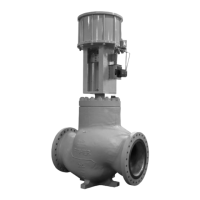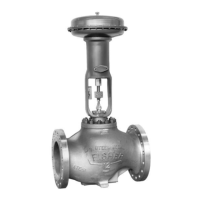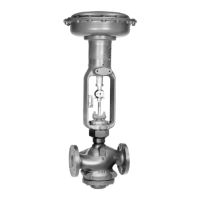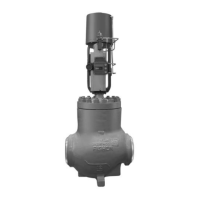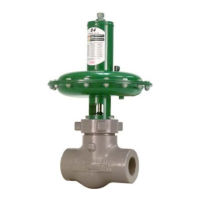Instruction Manual
D100398X012
ET Valve
November 2017
9
prying tool around the bonnet until the bonnet loosens. If no fluid leaks from the joint, remove the nuts or cap
screws completely and carefully lift the bonnet off the valve.
Table 4. Recommended Torque for Packing Flange Nuts
VALVE STEM DIAMETER
PRESSURE
RATING
GRAPHITE TYPE PACKING PTFE TYPE PACKING
Minimum Torque Maximum Torque Minimum Torque Maximum Torque
mm Inches NSm LbfSin NSm LbfSin NSm LbfSin NSm LbfSin
9.5 3/8
CL125, 150 3 27 5 40 1 13 2 19
CL250, 300 4 36 6 53 2 17 3 26
CL600 6 49 8 73 3 23 4 35
12.7 1/2
CL125, 150 5 44 8 66 2 21 4 31
CL250, 300 7 59 10 88 3 28 5 42
CL600 9 81 14 122 4 39 7 58
19.1 3/4
CL125, 150 11 99 17 149 5 47 8 70
CL250, 300 15 133 23 199 7 64 11 95
CL600 21 182 31 274 10 87 15 131
25.4 1
CL300 26 226 38 339 12 108 18 162
CL600 35 310 53 466 17 149 25 223
31.8 1‐1/4
CL300 36 318 54 477 17 152 26 228
CL600 49 437 74 655 24 209 36 314
5. Remove the locknut and separate the valve plug and stem from the bonnet. Set the parts on a protective surface to
prevent damage to gasket or seating surfaces.
CAUTION
To prevent possible product damage, cover the opening in the valve in the following procedure to prevent foreign material
from getting into the valve body cavity.
6. Remove the bonnet gasket (key 10, figure 16, 17, or 20) and cover the opening in the valve to protect the gasket
surface and prevent foreign material from getting into the valve body cavity.
7. Remove the packing flange nuts, packing flange, upper wiper, and packing follower (keys 5, 3, 12, and 13, figure
14). Carefully push out all the remaining packing parts from the valve side of the bonnet using a rounded rod or
other tool that will not scratch the packing box wall. Clean the packing box and the metal packing parts.
8. Inspect the valve stem threads and packing box surfaces for any sharp edges which might cut the packing.
Scratches or burrs could cause packing box leakage or damage to the new packing. If the surface condition cannot
be improved by light sanding, replace the damaged parts by following the appropriate steps in the Trim
Maintenance procedure.
9. Remove the covering protecting the valve body cavity and install a new bonnet gasket (key 10, figure 16, 17, or 20),
making sure the gasket seating surfaces are clean and smooth. Then slide the bonnet over the stem and onto the
stud bolts (key 15, figure 16, 17, or 20) or onto the valve body cavity if cap screws (not shown) will be used instead.
Note
Proper performance of the bolting procedures in step 10 compresses the spiral wound gasket (key 12, figure 16 or 17) or load ring
(key 26, figure 20) enough to both load and seal the seat ring gasket (key 13, figure 16, 17 or 20). It also compresses the outer
edge of the bonnet gasket (key 10, figure 16 through 20) enough to seal the body‐to‐bonnet joint.
The proper bolting procedures in step 10 include‐‐but are not limited to‐‐ensuring that bolting threads are clean, and evenly
tightening the cap screws, or the nuts onto the studs, in a crisscross pattern. Tightening one cap screw or nut may loosen an
adjacent cap screw or nut. Repeat the crisscross tightening pattern several times until each cap screw or nut is tight and the
body‐to‐bonnet seal is made. When the operating temperature has been reached, perform this torquing procedure once again.
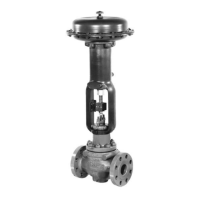
